instrument panel PONTIAC TORRENT 2009 Owners Manual
[x] Cancel search | Manufacturer: PONTIAC, Model Year: 2009, Model line: TORRENT, Model: PONTIAC TORRENT 2009Pages: 436, PDF Size: 2.43 MB
Page 1 of 436
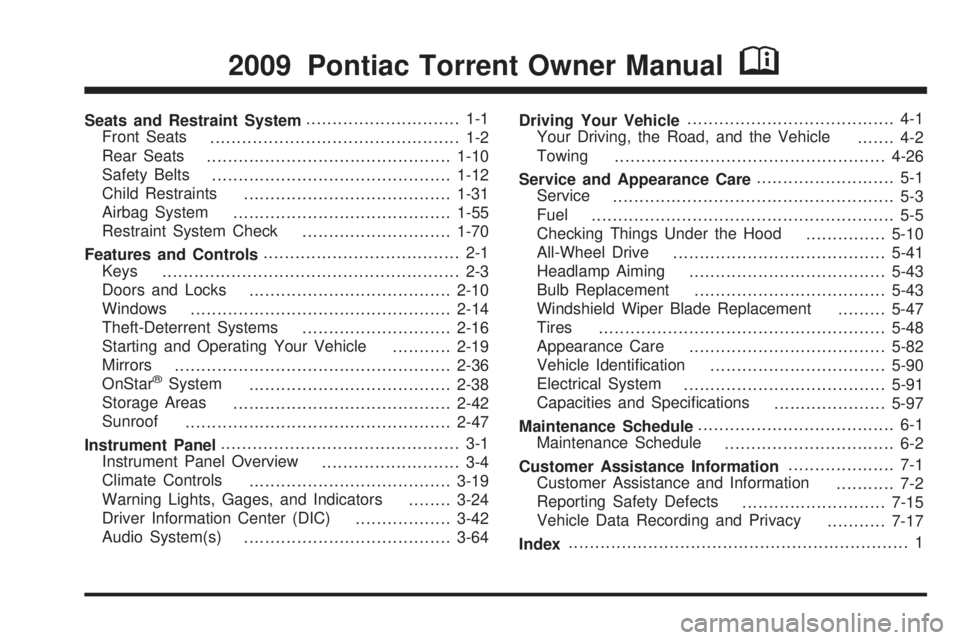
Seats and Restraint System............................. 1-1
Front Seats
............................................... 1-2
Rear Seats
..............................................1-10
Safety Belts
.............................................1-12
Child Restraints
.......................................1-31
Airbag System
.........................................1-55
Restraint System Check
............................1-70
Features and Controls..................................... 2-1
Keys
........................................................ 2-3
Doors and Locks
......................................2-10
Windows
.................................................2-14
Theft-Deterrent Systems
............................2-16
Starting and Operating Your Vehicle
...........2-19
Mirrors
....................................................2-36
OnStar
®System
......................................2-38
Storage Areas
.........................................2-42
Sunroof
..................................................2-47
Instrument Panel............................................. 3-1
Instrument Panel Overview
.......................... 3-4
Climate Controls
......................................3-19
Warning Lights, Gages, and Indicators
........3-24
Driver Information Center (DIC)
..................3-42
Audio System(s)
.......................................3-64Driving Your Vehicle....................................... 4-1
Your Driving, the Road, and the Vehicle
....... 4-2
Towing
...................................................4-26
Service and Appearance Care.......................... 5-1
Service
..................................................... 5-3
Fuel
......................................................... 5-5
Checking Things Under the Hood
...............5-10
All-Wheel Drive
........................................5-41
Headlamp Aiming
.....................................5-43
Bulb Replacement
....................................5-43
Windshield Wiper Blade Replacement
.........5-47
Tires
......................................................5-48
Appearance Care
.....................................5-82
Vehicle Identi�cation
.................................5-90
Electrical System
......................................5-91
Capacities and Speci�cations
.....................5-97
Maintenance Schedule..................................... 6-1
Maintenance Schedule
................................ 6-2
Customer Assistance Information.................... 7-1
Customer Assistance and Information
........... 7-2
Reporting Safety Defects
...........................7-15
Vehicle Data Recording and Privacy
...........7-17
Index................................................................ 1
2009 Pontiac Torrent Owner ManualM
Page 8 of 436
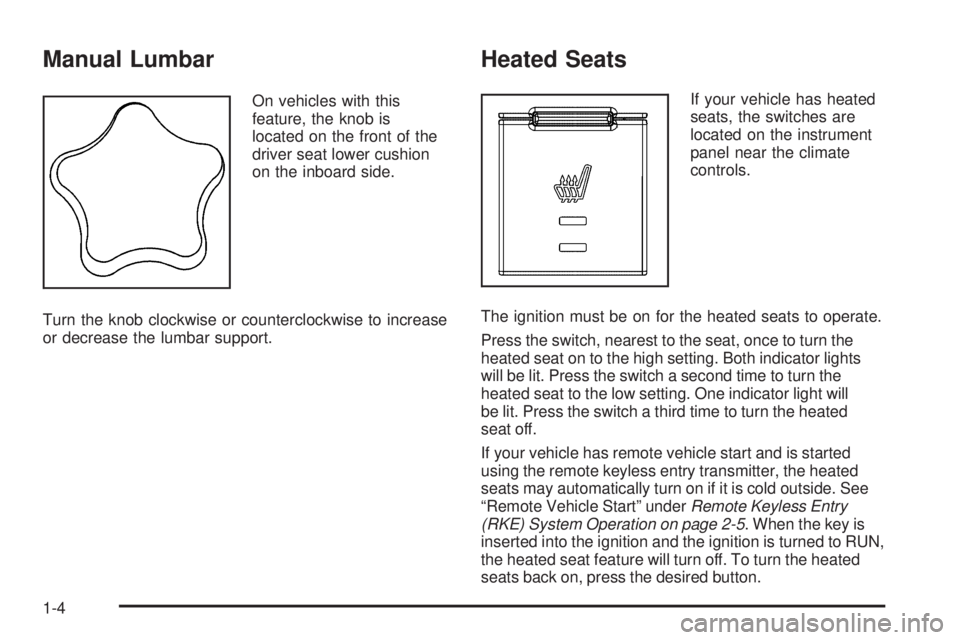
Manual Lumbar
On vehicles with this
feature, the knob is
located on the front of the
driver seat lower cushion
on the inboard side.
Turn the knob clockwise or counterclockwise to increase
or decrease the lumbar support.
Heated Seats
If your vehicle has heated
seats, the switches are
located on the instrument
panel near the climate
controls.
The ignition must be on for the heated seats to operate.
Press the switch, nearest to the seat, once to turn the
heated seat on to the high setting. Both indicator lights
will be lit. Press the switch a second time to turn the
heated seat to the low setting. One indicator light will
be lit. Press the switch a third time to turn the heated
seat off.
If your vehicle has remote vehicle start and is started
using the remote keyless entry transmitter, the heated
seats may automatically turn on if it is cold outside. See
“Remote Vehicle Start” underRemote Keyless Entry
(RKE) System Operation on page 2-5. When the key is
inserted into the ignition and the ignition is turned to RUN,
the heated seat feature will turn off. To turn the heated
seats back on, press the desired button.
1-4
Page 19 of 436
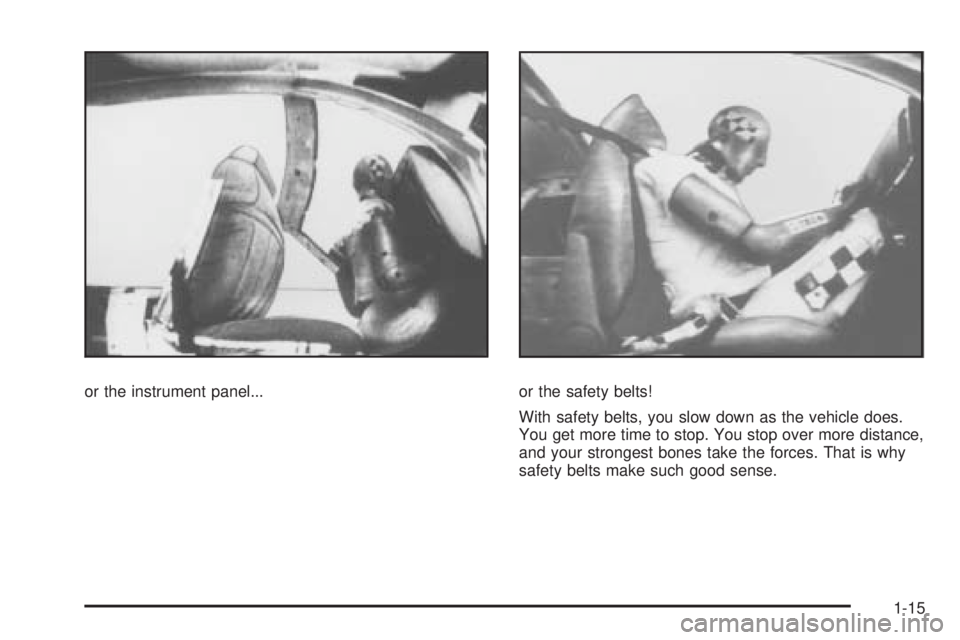
or the instrument panel... or the safety belts!
With safety belts, you slow down as the vehicle does.
You get more time to stop. You stop over more distance,
and your strongest bones take the forces. That is why
safety belts make such good sense.
1-15
Page 59 of 436
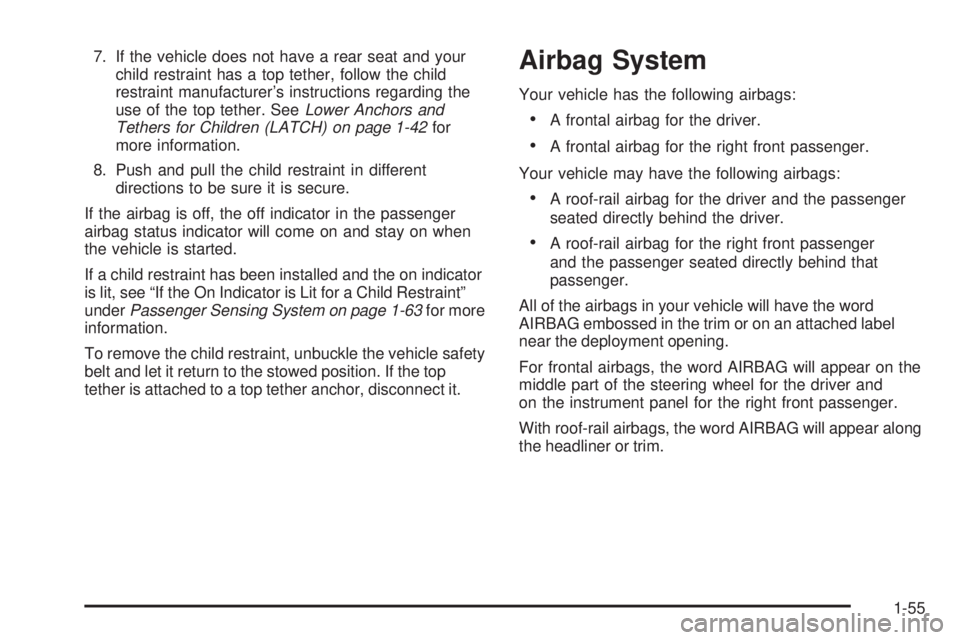
7. If the vehicle does not have a rear seat and your
child restraint has a top tether, follow the child
restraint manufacturer’s instructions regarding the
use of the top tether. SeeLower Anchors and
Tethers for Children (LATCH) on page 1-42for
more information.
8. Push and pull the child restraint in different
directions to be sure it is secure.
If the airbag is off, the off indicator in the passenger
airbag status indicator will come on and stay on when
the vehicle is started.
If a child restraint has been installed and the on indicator
is lit, see “If the On Indicator is Lit for a Child Restraint”
underPassenger Sensing System on page 1-63for more
information.
To remove the child restraint, unbuckle the vehicle safety
belt and let it return to the stowed position. If the top
tether is attached to a top tether anchor, disconnect it.Airbag System
Your vehicle has the following airbags:
A frontal airbag for the driver.
A frontal airbag for the right front passenger.
Your vehicle may have the following airbags:
A roof-rail airbag for the driver and the passenger
seated directly behind the driver.
A roof-rail airbag for the right front passenger
and the passenger seated directly behind that
passenger.
All of the airbags in your vehicle will have the word
AIRBAG embossed in the trim or on an attached label
near the deployment opening.
For frontal airbags, the word AIRBAG will appear on the
middle part of the steering wheel for the driver and
on the instrument panel for the right front passenger.
With roof-rail airbags, the word AIRBAG will appear along
the headliner or trim.
1-55
Page 60 of 436
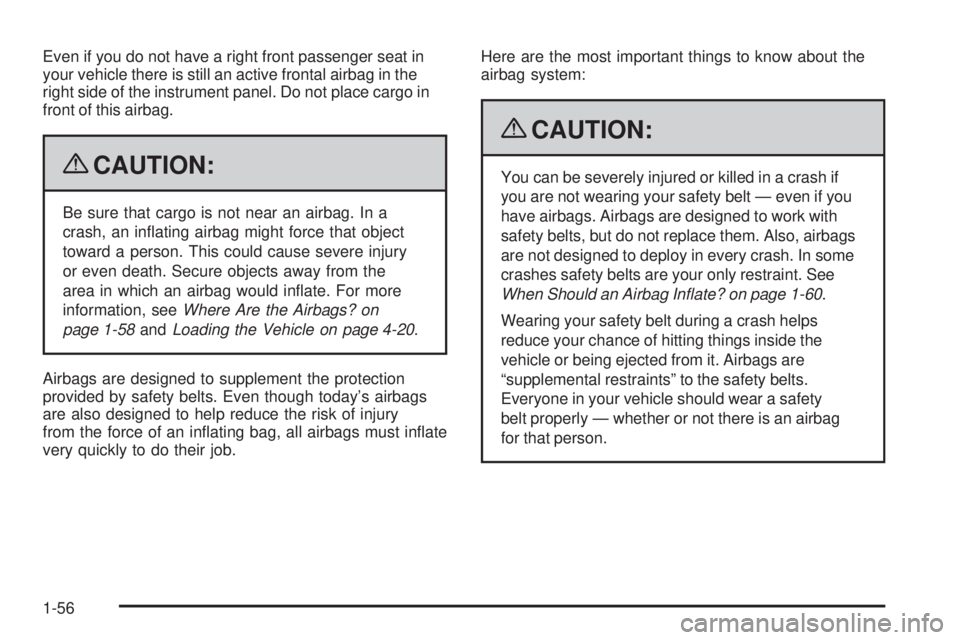
Even if you do not have a right front passenger seat in
your vehicle there is still an active frontal airbag in the
right side of the instrument panel. Do not place cargo in
front of this airbag.
{CAUTION:
Be sure that cargo is not near an airbag. In a
crash, an in�ating airbag might force that object
toward a person. This could cause severe injury
or even death. Secure objects away from the
area in which an airbag would in�ate. For more
information, seeWhere Are the Airbags? on
page 1-58andLoading the Vehicle on page 4-20.
Airbags are designed to supplement the protection
provided by safety belts. Even though today’s airbags
are also designed to help reduce the risk of injury
from the force of an in�ating bag, all airbags must in�ate
very quickly to do their job.Here are the most important things to know about the
airbag system:
{CAUTION:
You can be severely injured or killed in a crash if
you are not wearing your safety belt — even if you
have airbags. Airbags are designed to work with
safety belts, but do not replace them. Also, airbags
are not designed to deploy in every crash. In some
crashes safety belts are your only restraint. See
When Should an Airbag Inflate? on page 1-60.
Wearing your safety belt during a crash helps
reduce your chance of hitting things inside the
vehicle or being ejected from it. Airbags are
“supplemental restraints” to the safety belts.
Everyone in your vehicle should wear a safety
belt properly — whether or not there is an airbag
for that person.
1-56
Page 61 of 436
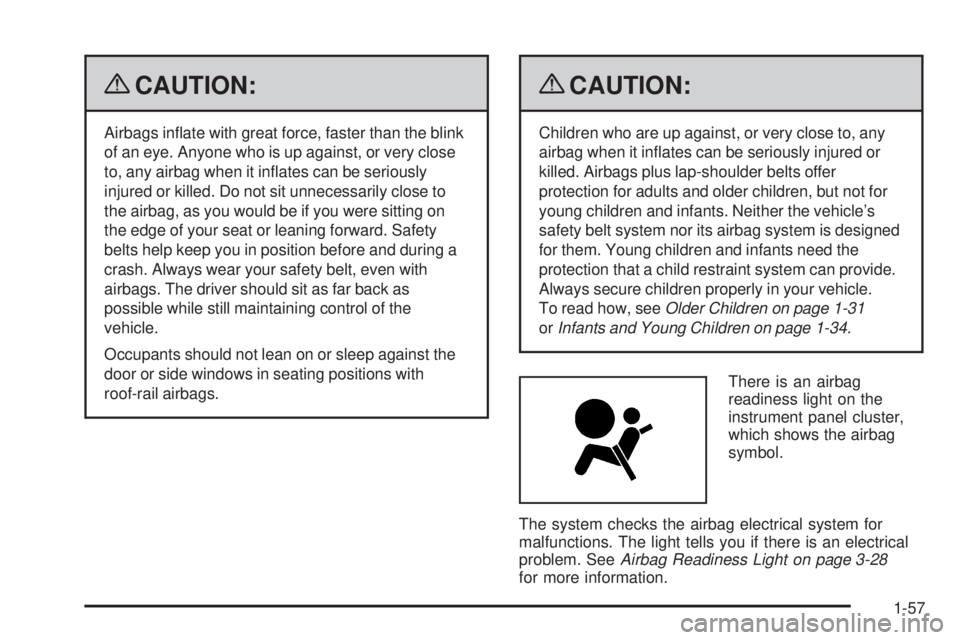
{CAUTION:
Airbags in�ate with great force, faster than the blink
of an eye. Anyone who is up against, or very close
to, any airbag when it in�ates can be seriously
injured or killed. Do not sit unnecessarily close to
the airbag, as you would be if you were sitting on
the edge of your seat or leaning forward. Safety
belts help keep you in position before and during a
crash. Always wear your safety belt, even with
airbags. The driver should sit as far back as
possible while still maintaining control of the
vehicle.
Occupants should not lean on or sleep against the
door or side windows in seating positions with
roof-rail airbags.
{CAUTION:
Children who are up against, or very close to, any
airbag when it in�ates can be seriously injured or
killed. Airbags plus lap-shoulder belts offer
protection for adults and older children, but not for
young children and infants. Neither the vehicle’s
safety belt system nor its airbag system is designed
for them. Young children and infants need the
protection that a child restraint system can provide.
Always secure children properly in your vehicle.
To read how, seeOlder Children on page 1-31
orInfants and Young Children on page 1-34.
There is an airbag
readiness light on the
instrument panel cluster,
which shows the airbag
symbol.
The system checks the airbag electrical system for
malfunctions. The light tells you if there is an electrical
problem. SeeAirbag Readiness Light on page 3-28
for more information.
1-57
Page 62 of 436
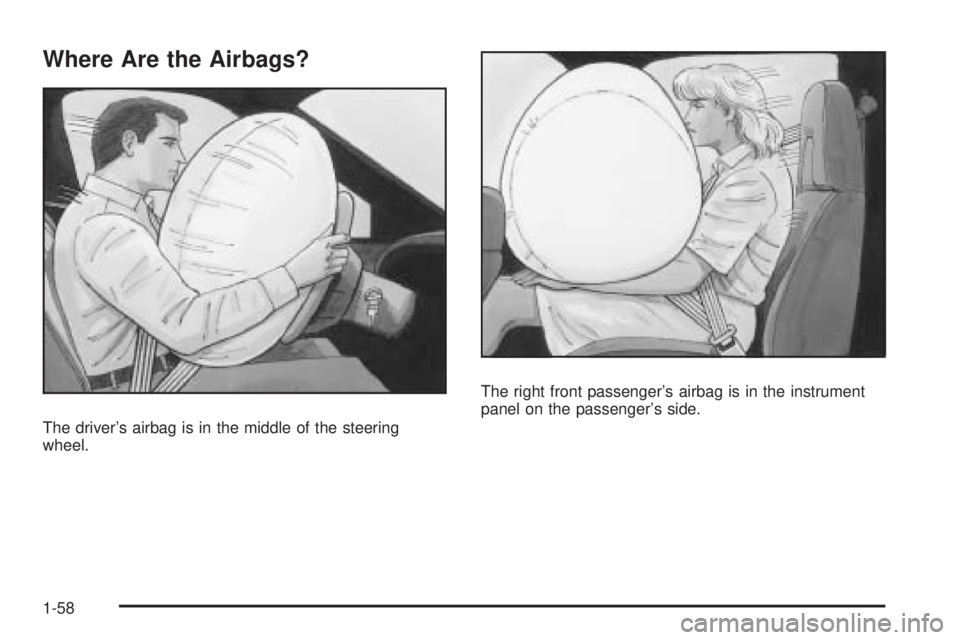
Where Are the Airbags?
The driver’s airbag is in the middle of the steering
wheel.The right front passenger’s airbag is in the instrument
panel on the passenger’s side.
1-58
Page 65 of 436
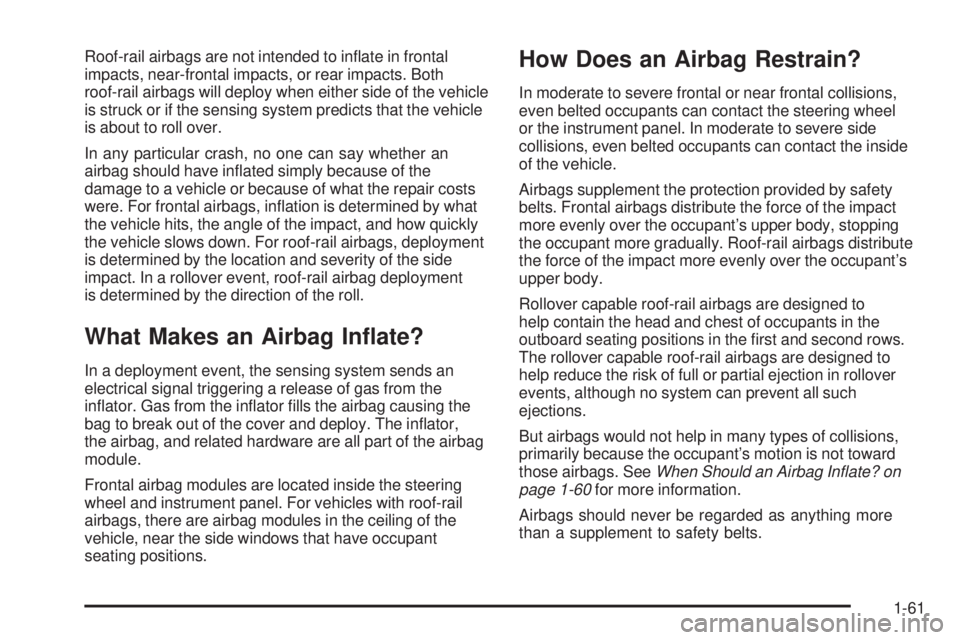
Roof-rail airbags are not intended to in�ate in frontal
impacts, near-frontal impacts, or rear impacts. Both
roof-rail airbags will deploy when either side of the vehicle
is struck or if the sensing system predicts that the vehicle
is about to roll over.
In any particular crash, no one can say whether an
airbag should have in�ated simply because of the
damage to a vehicle or because of what the repair costs
were. For frontal airbags, in�ation is determined by what
the vehicle hits, the angle of the impact, and how quickly
the vehicle slows down. For roof-rail airbags, deployment
is determined by the location and severity of the side
impact. In a rollover event, roof-rail airbag deployment
is determined by the direction of the roll.
What Makes an Airbag In�ate?
In a deployment event, the sensing system sends an
electrical signal triggering a release of gas from the
in�ator. Gas from the in�ator �lls the airbag causing the
bag to break out of the cover and deploy. The in�ator,
the airbag, and related hardware are all part of the airbag
module.
Frontal airbag modules are located inside the steering
wheel and instrument panel. For vehicles with roof-rail
airbags, there are airbag modules in the ceiling of the
vehicle, near the side windows that have occupant
seating positions.
How Does an Airbag Restrain?
In moderate to severe frontal or near frontal collisions,
even belted occupants can contact the steering wheel
or the instrument panel. In moderate to severe side
collisions, even belted occupants can contact the inside
of the vehicle.
Airbags supplement the protection provided by safety
belts. Frontal airbags distribute the force of the impact
more evenly over the occupant’s upper body, stopping
the occupant more gradually. Roof-rail airbags distribute
the force of the impact more evenly over the occupant’s
upper body.
Rollover capable roof-rail airbags are designed to
help contain the head and chest of occupants in the
outboard seating positions in the �rst and second rows.
The rollover capable roof-rail airbags are designed to
help reduce the risk of full or partial ejection in rollover
events, although no system can prevent all such
ejections.
But airbags would not help in many types of collisions,
primarily because the occupant’s motion is not toward
those airbags. SeeWhen Should an Airbag Inflate? on
page 1-60for more information.
Airbags should never be regarded as anything more
than a supplement to safety belts.
1-61
Page 67 of 436
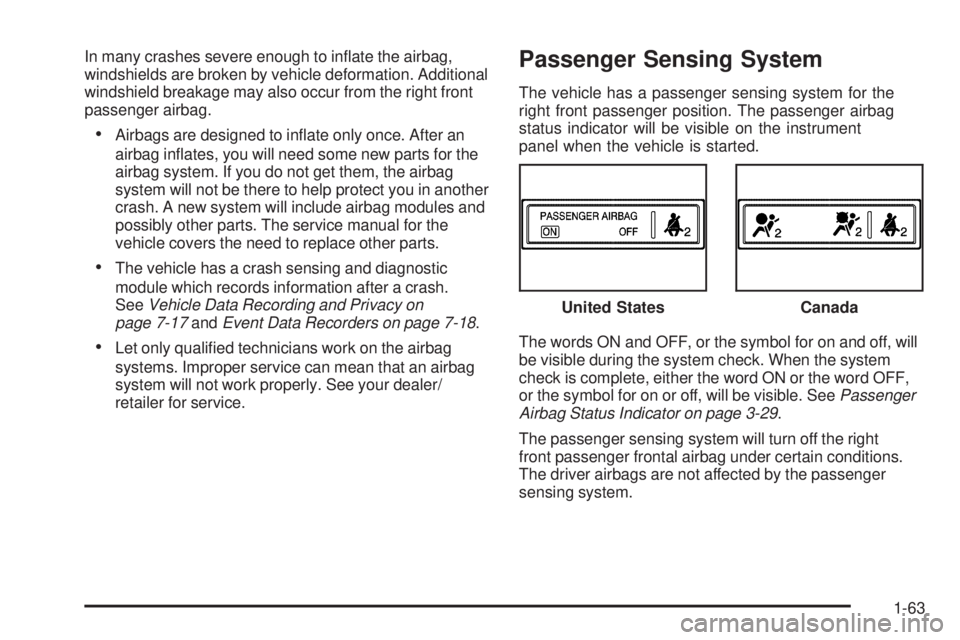
In many crashes severe enough to in�ate the airbag,
windshields are broken by vehicle deformation. Additional
windshield breakage may also occur from the right front
passenger airbag.
Airbags are designed to in�ate only once. After an
airbag in�ates, you will need some new parts for the
airbag system. If you do not get them, the airbag
system will not be there to help protect you in another
crash. A new system will include airbag modules and
possibly other parts. The service manual for the
vehicle covers the need to replace other parts.
The vehicle has a crash sensing and diagnostic
module which records information after a crash.
SeeVehicle Data Recording and Privacy on
page 7-17andEvent Data Recorders on page 7-18.
Let only quali�ed technicians work on the airbag
systems. Improper service can mean that an airbag
system will not work properly. See your dealer/
retailer for service.
Passenger Sensing System
The vehicle has a passenger sensing system for the
right front passenger position. The passenger airbag
status indicator will be visible on the instrument
panel when the vehicle is started.
The words ON and OFF, or the symbol for on and off, will
be visible during the system check. When the system
check is complete, either the word ON or the word OFF,
or the symbol for on or off, will be visible. SeePassenger
Airbag Status Indicator on page 3-29.
The passenger sensing system will turn off the right
front passenger frontal airbag under certain conditions.
The driver airbags are not affected by the passenger
sensing system.United States
Canada
1-63
Page 72 of 436

Servicing Your Airbag-Equipped
Vehicle
Airbags affect how the vehicle should be serviced.
There are parts of the airbag system in several places
around the vehicle. Your dealer/retailer and the
service manual have information about servicing the
vehicle and the airbag system. To purchase a service
manual, seeService Publications Ordering Information
on page 7-16.
{CAUTION:
For up to 10 seconds after the ignition is turned off
and the battery is disconnected, an airbag can still
in�ate during improper service. You can be injured
if you are close to an airbag when it in�ates. Avoid
yellow connectors. They are probably part of the
airbag system. Be sure to follow proper service
procedures, and make sure the person performing
work for you is quali�ed to do so.
Adding Equipment to Your
Airbag-Equipped Vehicle
Q:Is there anything I might add to or change
about the vehicle that could keep the airbags
from working properly?
A:Yes. If you add things that change the vehicle’s
frame, bumper system, height, front end or side
sheet metal, they may keep the airbag system from
working properly. Changing or moving any parts
of the front seats, safety belts, the airbag sensing
and diagnostic module, steering wheel, instrument
panel, roof-rail airbag modules, ceiling headliner
or pillar garnish trim, overhead console, front
sensors, side impact sensors, rollover sensor
module, or airbag wiring can affect the operation
of the airbag system.
In addition, the vehicle has a passenger sensing
system for the right front passenger position, which
includes sensors that are part of the passenger seat.
1-68